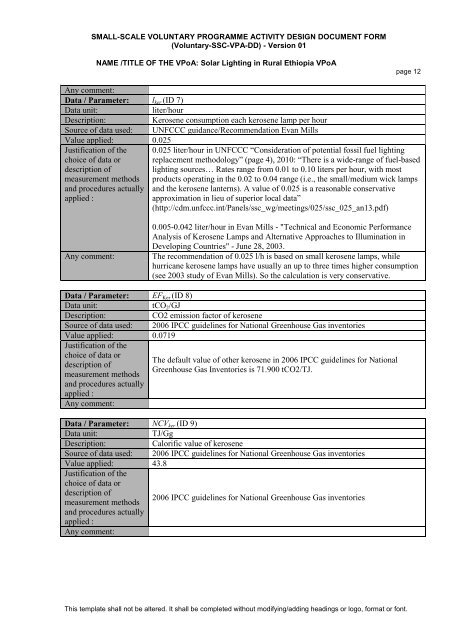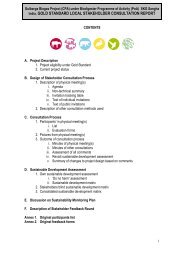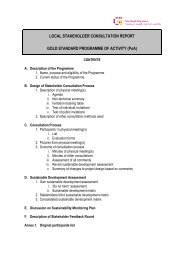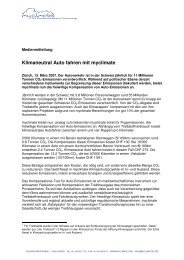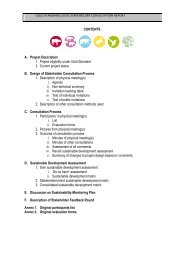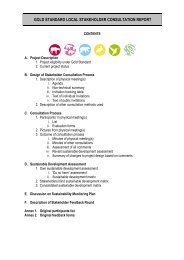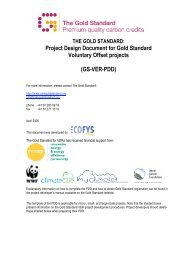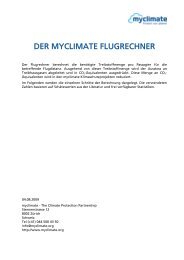Ethiopia lighting VPA-SSC-DD - MyClimate
Ethiopia lighting VPA-SSC-DD - MyClimate
Ethiopia lighting VPA-SSC-DD - MyClimate
Create successful ePaper yourself
Turn your PDF publications into a flip-book with our unique Google optimized e-Paper software.
SMALL-SCALE VOLUNTARY PROGRAMME ACTIVITY DESIGN DOCUMENT FORM<br />
(Voluntary-<strong>SSC</strong>-<strong>VPA</strong>-<strong>DD</strong>) - Version 01<br />
NAME /TITLE OF THE VPoA: Solar Lighting in Rural <strong>Ethiopia</strong> VPoA<br />
Any comment:<br />
Data / Parameter: lker (ID 7)<br />
Data unit: liter/hour<br />
Description: Kerosene consumption each kerosene lamp per hour<br />
Source of data used: UNFCCC guidance/Recommendation Evan Mills<br />
Value applied: 0.025<br />
Justification of the<br />
choice of data or<br />
description of<br />
measurement methods<br />
and procedures actually<br />
applied :<br />
This template shall not be altered. It shall be completed without modifying/adding headings or logo, format or font.<br />
page 12<br />
0.025 liter/hour in UNFCCC “Consideration of potential fossil fuel <strong>lighting</strong><br />
replacement methodology” (page 4), 2010: “There is a wide-range of fuel-based<br />
<strong>lighting</strong> sources… Rates range from 0.01 to 0.10 liters per hour, with most<br />
products operating in the 0.02 to 0.04 range (i.e., the small/medium wick lamps<br />
and the kerosene lanterns). A value of 0.025 is a reasonable conservative<br />
approximation in lieu of superior local data”<br />
(http://cdm.unfccc.int/Panels/ssc_wg/meetings/025/ssc_025_an13.pdf)<br />
0.005-0.042 liter/hour in Evan Mills - "Technical and Economic Performance<br />
Analysis of Kerosene Lamps and Alternative Approaches to Illumination in<br />
Developing Countries" - June 28, 2003.<br />
Any comment: The recommendation of 0.025 l/h is based on small kerosene lamps, while<br />
hurricane kerosene lamps have usually an up to three times higher consumption<br />
(see 2003 study of Evan Mills). So the calculation is very conservative.<br />
Data / Parameter: EFKer (ID 8)<br />
Data unit: tCO2/GJ<br />
Description: CO2 emission factor of kerosene<br />
Source of data used: 2006 IPCC guidelines for National Greenhouse Gas inventories<br />
Value applied: 0.0719<br />
Justification of the<br />
choice of data or<br />
description of<br />
measurement methods<br />
and procedures actually<br />
applied :<br />
Any comment:<br />
The default value of other kerosene in 2006 IPCC guidelines for National<br />
Greenhouse Gas Inventories is 71.900 tCO2/TJ.<br />
Data / Parameter: NCVker (ID 9)<br />
Data unit: TJ/Gg<br />
Description: Calorific value of kerosene<br />
Source of data used: 2006 IPCC guidelines for National Greenhouse Gas inventories<br />
Value applied: 43.8<br />
Justification of the<br />
choice of data or<br />
description of<br />
2006 IPCC guidelines for National Greenhouse Gas inventories<br />
measurement methods<br />
and procedures actually<br />
applied :<br />
Any comment:


